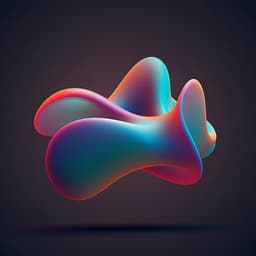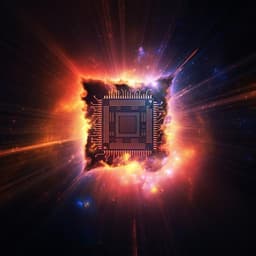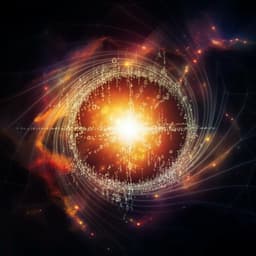
Physics
Relativistic-intensity near-single-cycle light waveforms at kHz repetition rate
M. Quillé, A. Vermier, et al.
Discover groundbreaking advancements in ultra-intense and ultra-short light sources, showcasing the ability to produce waveform-controlled 1.5-cycle pulses with significant implications for laser wakefield acceleration of relativistic energy electrons. This fascinating research was conducted by Marie Quillé, Aline Vermier, and their colleagues.
Playback language: English
Introduction
Waveform-controlled few-cycle laser pulses are powerful optical tools combining attosecond-scale temporal precision with ultra-high electromagnetic field strengths. For over a decade, single-cycle laser transients have been available, but their average and peak powers were limited, restricting their use primarily to strong-field laser-atom interactions. Carrier-envelope phase (CEP) control in these pulses significantly advanced attosecond science, furthering our understanding of ultrafast quantum dynamics. However, achieving relativistic intensities (where electron quiver energy surpasses their rest mass energy) requires significantly higher field strengths (≥10¹³ V/m), introducing highly nonlinear electron dynamics and the magnetic component of the Lorentz force. Relativistic laser-matter interaction is a forefront area in contemporary physics, driving the development of secondary particle and light sources such as laser-plasma electron accelerators and plasma mirror-based attosecond extreme ultraviolet sources. The challenge has been to create CEP-controlled few-cycle pulses capable of driving these relativistic interactions with attosecond precision.
Recent advancements have increased the power of few-cycle laser pulse sources. Broadband optical parametric chirped pulse amplifiers (OPCPAs) achieve multi-TW peak power, but their high pump energies limit repetition rates (typically 10 Hz), hindering CEP stabilization. While OPCPA-based sources have enabled relativistic laser-plasma interactions, scaling average power has proven difficult. High-repetition-rate (100 kHz) ytterbium-based fiber CPA technology combined with hollow-core fiber (HCF) nonlinear post-compression has yielded >200 W sub-2-cycle pulses, but CEP locking remains a challenge. Progress in high-repetition-rate pump lasers and CEP-stable seed generation for TW-class OPCPAs has led to ~10 W average power sub-3-cycle pulses with stable CEP, but their high-field applications are still being explored.
Novel schemes, such as thin-film compression and plasma-based photon deceleration, aim to generate terawatt or even petawatt few-cycle pulses. A competing approach, HCF-based post-compression of pulses from Ti:sapphire chirped pulse amplification (CPA) systems, has produced 2-cycle pulses at 1 TW peak power, although without CEP control. The current study builds upon previous work that achieved multi-mJ pulse energy, sub-2-cycle duration, and CEP locking, and further improvements led to relativistic electron energies in LWFA at a kHz repetition rate. This paper presents a more advanced setup with significant performance enhancements: achieving 1.5-cycle pulses with TW peak power and pulse stability suitable for relativistic-intensity laser-matter experiments. The kHz repetition rate, high contrast ratio, and high intensity make this source ideal for sub-cycle time-controlled relativistic interactions.
Literature Review
The introduction extensively reviews existing literature on the generation of ultra-short and ultra-intense laser pulses. It highlights the limitations of previous techniques, such as OPCPAs (limited repetition rate), high-repetition-rate fiber CPAs (lack of CEP stabilization), and other novel schemes (still in early stages of development). The authors emphasize the need for a light source that combines high peak power, short pulse duration, high repetition rate, and CEP stability, which is crucial for controlling relativistic laser-plasma interactions with attosecond precision. The review sets the stage for the presented work, positioning it as a significant advancement in the field by addressing the previously identified limitations.
Methodology
The researchers employed a vacuum-integrated post-compressor setup. A Ti:sapphire double CPA chain provided 10 mJ pulses (shot-to-shot stability <0.3% rms) at 1 kHz with a high temporal contrast ratio (>10¹⁰ at −10 ps). Pulses were partially compressed to 200 fs in air before entering a vacuum beamline to prevent nonlinear beam degradation. Final compression to 24 fs (Fourier transform-limited duration) was achieved using eight highly dispersive chirped mirrors. The double CPA seed laser was improved compared to previous versions, focusing on enhancing pulse energy stability crucial for CEP locking. This was accomplished through replacing the front-end pump laser, optimizing the power amplifier layout, and improving environmental control. The post-compression stage utilized self-phase modulation (SPM) in a gas-filled HCF, a technique chosen for its ability to generate well-compressible broadband pulses with excellent beam profiles. Three key strategies were implemented to scale this technique to the 0.4 TW peak power of the CPA chain:
1. **Stretched flexible HCF technology:** A 2.5 m long, 536 µm inner diameter HCF allowed for arbitrary waveguide length without compromising waveguiding properties. A conical glass taper protected against damage from misalignments.
2. **Differential pumping:** High-purity helium was differentially pumped through the HCF, creating a pressure gradient (from <1 mbar at the entrance to 2 bar at the output) to enhance coupling efficiency and stability and mitigate nonlinear effects.
3. **Circular polarization:** Circular polarization was used to reduce multi-photon ionization, self-focusing, and energy cycling between fiber modes. Two broadband quarter-wave plates were used to switch polarization.
The output chamber included mirrors for diagnostics and active alignment. A fused silica window separated the helium-filled chamber from the downstream vacuum beamline. Motorized fused silica wedges and highly dispersive chirped mirrors compensated for GDD and TOD. A d-scan device provided precise temporal measurements. CEP stabilization was achieved using a homemade f-to-2f interferometer, with the error signal modulating the oscillator locking electronics to correct for slow drifts. The pulse duration was tunable (25 fs down to 3.5 fs) by adjusting the helium pressure and dispersion. The experiment also included detailed spectral measurements and numerical simulations (solving the one-dimensional generalized nonlinear Schrödinger equation) to model SPM-induced spectral broadening.
Key Findings
The study achieved a record pulse duration of 1.5 cycles (3.4 ± 0.1 fs FWHM) for TW peak power pulses at a 1 kHz repetition rate. This was close to the Fourier transform limit (2.9 fs). The system demonstrated excellent pulse-to-pulse stability (0.4% rms for energy and 150 mrad rms for CEP). The HCF post-compression stage showed good energy scaling, avoiding significant ionization-induced losses. The spectral broadening followed the expected behavior for SPM-induced broadening, matching numerical simulations without the need for including ionization or spatial effects. Pulse duration was tunable from 25 fs down to 3.5 fs by adjusting the helium pressure and dispersion. Finally, the system's capabilities enabled observation of the first experimental indications of CEP effects in relativistic LWFA in the near-single-cycle regime.
Discussion
The results demonstrate a significant advancement in the generation of ultra-intense, near-single-cycle laser pulses. The combination of high peak power, short pulse duration, high repetition rate, and CEP stability opens new possibilities for studying relativistic laser-plasma interactions. The ability to tune the pulse duration offers flexibility for various experiments. The agreement between experimental results and numerical simulations validates the understanding of the underlying physical processes. The observation of CEP effects in relativistic LWFA provides compelling evidence for the importance of waveform control in manipulating relativistic electron acceleration. The high repetition rate is particularly valuable for statistical studies and applications requiring high average power.
Conclusion
This research presents a novel light source capable of generating waveform-controlled 1.5-cycle pulses with relativistic intensity at a 1 kHz repetition rate. The source's unique capabilities allow for precise control over relativistic laser-plasma interactions, demonstrated by the observation of CEP effects in LWFA. This opens exciting possibilities for advancing research in relativistic optics, laser-plasma acceleration, and attosecond science. Future work could involve further improvements in pulse duration and contrast ratio, exploring different gases in the HCF for optimized spectral broadening, and developing advanced applications in high-field physics and ultrafast science.
Limitations
While the system achieved excellent stability and near-Fourier-limited pulse durations, some minor limitations remain. The remaining negative TOD and phase distortion on the blue end of the spectrum prevented reaching the absolute Fourier transform limit. Future improvements in chirped mirror designs could further optimize pulse compression. The study focused on the source characteristics and initial evidence of CEP effects in LWFA. More extensive studies are needed to fully explore the potential of the source for advanced applications.
Related Publications
Explore these studies to deepen your understanding of the subject.







